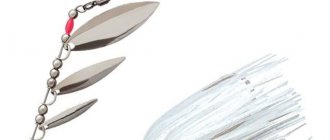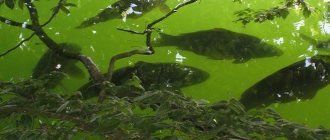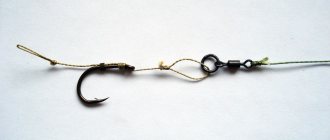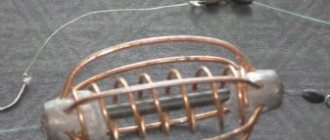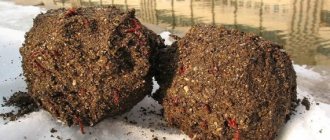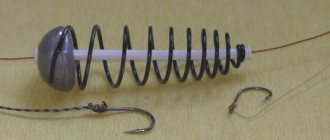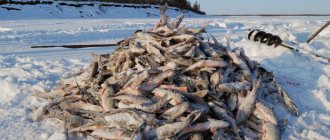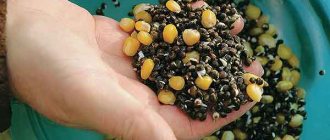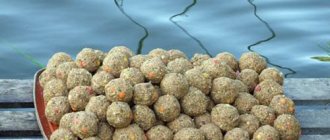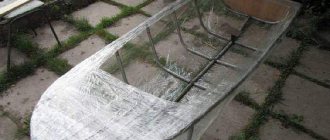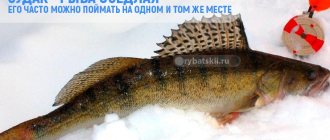It is possible to catch carp without feeding the fishing spot only in rare cases. Hoping for such luck is stupid and unproductive. For fishing to be effective and enjoyable, you need to pre-feed the carp.
Carp prefers to sit out in secluded places - in reeds, rubble, under snags. To lure him out of there into open water, carp bait is exactly what you need.
Specialized retail outlets offer carp anglers various options for ready-made bait mixtures. Despite this, many people prefer to prepare complementary food for carp with their own hands, knowing how picky this fish is and not showing interest in every food from the store.
If in some reservoirs carp have been fed certain types of foods for a long time, they have already developed certain food preferences, which should be taken into account when going fishing. Experienced fishermen understand that the best bait for carp is the one that is prepared taking into account the various situations that arise during fishing, the habits of the fish and the characteristics of the reservoir.
Complementary food for carp prepared at home has a number of advantages over industrially produced products:
- The fisherman knows exactly what products he used and is confident in the freshness of each of them.
- The composition is selected depending on the specific fishing conditions - taking into account the time of year, type of reservoir and other details.
- Homemade bait will cost one and a half to two times cheaper than store-bought bait.
- There is an opportunity to experiment with the taste of the bait, its color and smell.
- Since the composition of the mixture is known, the angler knows how it will behave in the water.
Before you start preparing carp bait in your own kitchen, you should find out what the requirements are for it.
Criteria for high-quality carp bait
In the matter of creating bait for carp, there can be no trifles. If he does not like the proposed mixture, he will simply leave the feeding area. Therefore, it is important to take into account all the nuances and adhere to all the rules at each stage of production.
Feeding composition
The mixture may include products of both plant and animal origin. The main condition is that they all must be fresh. Do not complicate the composition and use more than five ingredients in one mixture. When it’s warm, the composition of carp bait should be based on plant components, in cold weather – animal components.
Plant components that are taken as a basis:
- Sunflower cake. It has a strong odor that attracts carp.
- Breadcrumbs. By dissolving in water, they make the bait more noticeable, as if “dusting”.
- Corn grits.
- Oatmeal (ground oatmeal).
- Wheat or rye bran.
- Hemp seeds.
- Porridge.
- Cereals.
- Boilies and pellets of plant origin.
Breadcrumbs are a universal base. It is used for fishing with any plant bait. For canned corn baits, corn grits are used as a base. Oatmeal and bran are suitable for filling dough made with these products. Boilies and pellets form the basis of the bait when the bait consists of the same elements.
Garlic in the feeder kitchen. Milan Tychler.
Recently, garlic-scented baits have become very popular. On this wave, I tried to use granulated garlic in various bait mixtures, but unlike “garlic” baits, this did not bring impressive results.
After numerous experiments with increasing the dosage at different times of the year, no fundamental changes for the better were noticed, so for some time I stopped experimenting in this direction. Finally, I decided that garlic works in fish in a similar way to people, because when there is a lot of it, it completely changes things and not for the better. On the other hand, when the dosage was reduced to a minimum, I never noticed that the fish had any objections to this. In the end, I came to the final conclusion that it is not worth adding garlic in too large quantities, since it only appeals to fish as a seasoning. But garlic in fish as a “snack” is of much greater interest.
Great and mighty not only for culinary delicacies.
Some may consider my experiments with granulated garlic to be a failure, but the opposite is also true - I learned everything I wanted, and this served as the foundation for subsequent experiments. Now I could safely focus my attention on a more promising direction, namely, increasing the attractiveness of various granular supplements. But even here there were quite a lot of pitfalls, since not all additives absorb other odors well and their aroma is not easy to change. After a series of experiments, it became obvious that it was easiest to work with canned corn, which very quickly became saturated with the smell of garlic and retained it for a long time.
First, I want to tell you what you need to do to get the “smell of garlic.” There's nothing complicated. You need to crush a few cloves of garlic and pour a small amount of water into the resulting substance. Let it sit overnight and then strain through a cloth. Squeeze thoroughly, add a few drops of oil and pour into an airtight container. If the resulting attractant is poured into a container with a spray bottle, it will be convenient to use for flavoring dough, bread or other attachments.
Crush the garlic cloves using a special device.
Then add a small amount of water.
Stir and leave to infuse.
After steeping, drain through a cloth.
Squeeze thoroughly and add a few drops of oil.
Store in an airtight container.
It would seem, what difference does it make whether the bait mixture is flavored with garlic or the individual granular components of this mixture? But there really is a difference! In the first case, the smell of garlic “dissolves” quite quickly in water, since the treatment can be said to be superficial; in the second case, in addition to a more persistent smell, there is also a taste. Thus, fish react differently to different flavoring options.
All you need to do is pour garlic attractant onto the corn.
Garlic oil dissolves well in water, and there is no need to look for another “carrier”. To obtain garlic oil, it is enough to add a few drops of vegetable oil. After this procedure, the smell will spread faster, especially in warm water. But there is one nuance that is worth paying attention to. You can add oil only before use, since any vegetable oil tends to go rancid during long-term storage, so it is better to make a supply of garlic attractant, and immediately before fishing, add oil to the required amount, poured from a common container. Prepared garlic attractant is best stored in the refrigerator.
A “pillow” is made from a plastic bag, the contents of which must be shaken thoroughly.
A good alternative to water is corn syrup, which is always present in every can of canned corn. All you need to do is drain the liquid from the jar, add crushed garlic and let it brew. It is better to dry the corn grains, since after this procedure they will absorb more garlic attractant. To increase the effect, after the grains have been saturated with the smell, you need to drain the liquid and place the bag in the freezer for two days. Sub-zero temperatures contribute to the permeation of the internal structure of the grain with aroma and thus the aroma becomes more intense and persistent. When the grain prepared in this way is removed from the water, even after a long time, the smell of garlic is still clearly noticeable.
You need to drain the liquid, squeeze out the air and place the bag in the freezer for two days.
I noticed that carp and large bream really like garlic delicacies. They can be used throughout the season and remain highly effective even in cold water. Garlic has proven itself well, including in high water, when the fish ignored other odors. On the rivers, the aroma of garlic is respected by good chub. This also applies to podust and vimba, but more in cold water, when the water warms up, these fish do not react so clearly to garlic. I would say that for these fish this aroma becomes quite aggressive and therefore they prefer a more subtle aroma during warm water periods.
Large bream react to garlic baits and “garlic” bait even in early spring.
When using garlic during cooking and fishing, it is inevitable that it will get on your hands, and then you are guaranteed to live with this smell for quite a long time. I would like to recommend one proven option - with the help of lemon juice, the smell of garlic is easily “removed”, so you can plunge headlong into experiments without the risk of being ignored by others.
Source https://mrk.cz
Translation by Romeo
original translation
How to prepare bait for carp at home
There are a great many recipes for feeding carp. Each carp angler will tell you offhand a few for different weather conditions, seasons, the size of the expected catch, the nature of the reservoir and the individual tastes of its inhabitants. Let's look at the most popular of them.
Recipe for feeder fishing
This feeder bait for carp fishing is used for fishing in weak currents using a closed feeder. The mixture is gradually washed out of it, spreading the aroma downstream. You can cook the bait for the feeder as follows:
- Mix pearl barley, rolled oats and breadcrumbs.
- Pour in some warm water and stir again.
- Add dog or cat dry food, chopped worms, cake, honey and gelatin.
This bait works most effectively in summer and early autumn.
Summer bait recipes
There are a great many recipes for bait for carp in summer. Let's talk about some of them.
- Take two parts each of peas and pearl barley and one part each of millet cereal and breadcrumbs. The cereals are placed in an enamel container, filled with cold water and cooked until tender. When the mixture has cooled, add breadcrumbs and an attractant - anise or hemp oil. You can feed the crust with this bait in any water using balls or using a feeder. The first method is more effective because the crackers generate dust well, forming a cloud of turbidity.
- A kilogram of potatoes is boiled and mashed into a puree. Add a raw egg to it. Dill seeds and a glass of fried seeds are ground in a coffee grinder and added to the mass. A glass of cake is steamed and added to the mixture. Mix everything thoroughly and form into balls the size of an orange.
Of course, each carp angler has his own recipe for effective and effective feeding. Based on the recipes presented here, you can experiment with the components to get your own individual bait “trick”.
Recipe for spring
Take one kilogram of corn and wheat, wash it and fill it with water so that its level is 5 cm above the contents. Add one hundred grams of sugar and a bottle of flavoring with the smell of fruits or berries, anise or hemp. Mix everything and put it in a warm place for two days to ferment. The smell of the fermented mixture is very attractive to carp.
It is better to feed in the spring in places with a depth not exceeding two meters, and to fish from the shore.
Autumn recipe for cold water
This simple recipe, consisting of available products, has proven itself to be excellent in the autumn, when carp activity sharply decreases.
- 200 g of barley is poured with boiling water and steamed for two hours.
- 300 g of bran are placed in a separate bowl and also poured with boiling water.
- After half an hour, add 70 g of chopped peanuts (you can replace them with raisins) and two tablespoons of honey into the bran.
- The container with bran is wrapped in a blanket and left for another hour.
- Mix pearl barley with bran.
- Add a pinch of bloodworms and maggots.
- Anise flavor is added.
Do not get carried away with animal additives and attractants. Observe the measure, otherwise the result will be completely opposite - the pecking will stop altogether.
Assorted baits
This mixture is also easy to prepare and has proven to be excellent when hunting large prey in enclosed bodies of water. Used for spring and autumn fishing, when carp are deficient in protein.
The basis of the bait consists of the following ingredients:
- 2 kg of any cereal;
- 400 g each of cake and cat food in granules;
- 150 g canned corn;
- a dozen purchased sinking boilies;
- two tablespoons of honey;
- chopped worms and maggots (should make up about a twentieth of the total mass).
The cereal is boiled and allowed to sit for half an hour, after which the remaining ingredients are added to it and the mass is mixed.
While fishing, this base is filled with water and clay or soil is added. Balls are made from the resulting mass or feeders are charged with it.
Fruit porridge
This recipe is considered by many to be the best option for summer bait. It is prepared like this:
- take 400 g of pearl barley and corn grits, cook porridge from them, cool it;
- add two tablespoons of sunflower oil and liquefied honey (preferably herbs or acacia);
- add 400 g of breadcrumbs, 300 g of green peas and 100 g of grated fruit;
- knead well.
As you can see, most recipes involve the use of flavorings.
Catching bream with lard and garlic: fishing on the Oka, video, tackle, what kind of lard to take?
Catching bream is not very easy, since it is always very careful, and is also selective in its choice of food. In order to catch as many fish as possible, you should correctly select not only the bait, but also the tackle itself.
Not so, experienced fishermen discovered that bream can be easily caught for lard. Even well-fed fish bite on such bait very willingly. Largely due to its structure, lard is very convenient for baiting: it holds perfectly on the hook and does not slip off during casting.
As fishermen advise, lard with streaks should be applied, and a layer should be taken that is quite close to the skin. Bream actively bite on fresh and not frozen lard. The day before, fishermen cut it into small pieces and put it in the freezer overnight.
During the fishing process, the bulk of the lard is kept wrapped in several layers of paper or thick fabric. Only a couple of pieces are taken out from there so that they can warm up before they go to the bottom of the reservoir. This approach helps prevent the lard from spoiling, especially on hot days.
In principle, you can do it a little differently: dig a not too deep hole and put all the available stock there.
There are several useful tips that can make this bait even more attractive to the fisherman:
- Lard goes well with other types of bait - bloodworms, worms and others. They will act as a natural flavoring agent that will attract fish even from a fairly long distance;
- Lard can be slightly colored using food coloring.
How to properly assemble the tackle when catching bream with lard?
The average weight of bream ranges from one to three or four kilograms, but quite large specimens can be caught, weighing five kilos or even more. In principle, it is clear that bream is far from the largest fish that lives in the waters of the middle zone, and moreover, it is not very strong.
However, bream fishing tackle should be as durable as possible. It is very convenient to use the so-called half-bottom, on which fish actively bite in the spring months, especially immediately after the ice melts or during high water. The fact is that fishing during this period using a float rod is inconvenient due to the fairly strong current.
It is also difficult to use an ordinary bottom fish at this time, since it is effective in deep water, and bream during this period comes close to the coastline. The maximum thickness of the fishing line for this gear is about 0.4 mm , the leashes are taken even thinner - no more than 0.17 mm, thicker gear will scare away this cautious fish.
By using a thin fishing line, you don’t have to worry about it being carried away by the current. It usually does not have high tensile strength, but this is easily compensated for by the flexible rod.
What kind of lard should you take for fishing bream?
The success of fishing largely depends on the quality of the bait. In principle, fishermen use salted or unleavened lard, with or without streaks, with the addition of various flavorings such as pepper or garlic, and so on.
The choice of bait directly depends on the taste preference of the fish. The fact is that bream is picky in terms of food choice , so one day it can eat lard with the smell of garlic, and the next it will give preference to ordinary unleavened lard.
As mentioned earlier, lard is first cut into small pieces. Their dimensions should be approximately 0.5x0.5 cm. They immediately think about whether this bait will be combined with maggots or bloodworms.
It is absolutely not necessary to cut the entire piece of lard, because it is possible that after you start fishing, pieces of other sizes - larger or smaller - will be more suitable. It is advisable that the lard be as fresh as possible.
Lure
Although lard is an excellent bait when fishing for bream, it is not advisable to use it as bait. The fact is that it will either float to the surface or be located close to it, so adding lard will not affect the effectiveness of complementary feeding in any way.
The bait must necessarily consist only of natural animal-type flavorings. The most successful solution would be to use maggots or bloodworms. You can catch bream with lard using bottom or float gear , and the fish will be excellent for lard not only in the warm season, but also in winter.
It is best to store lard in a cooler bag or wrap it in foil, since in hot weather it thaws almost instantly and begins to spoil.
Bream will no longer bite on spoiled lard, but catfish can swallow such bait, but landing it on the surface of the reservoir will be much more difficult, since this fish is stronger.
Half-bottom (catch fishing)
This type of gear is excellent for fishing a body of water nearby near the coastline, especially in the spring months during high water. At this time, the float rod will create certain inconveniences due to the fact that the current in the reservoirs is quite strong.
It is not possible to use a full-fledged bottom fish, since the presence of fish in the area of the coastline does not allow the use of all its positive qualities. Despite the fact that the thickness of the fishing line of such gear is not too thick, it will not be carried away by the current.
Due to the fact that the fishing line is quite thin, it can break if the fish makes a strong jerk, but this disadvantage is successfully compensated for with the help of a flexible rod.
This indicator is called “test”, it is indicated on the butt part of the tackle.
Depending on the size of the test, a specific sinker is selected. If the rod is homemade, then the most suitable weight of the sinker is chosen empirically .
You can determine whether a fish has bitten using the rod tip. A bream that has bitten senses danger and begins to make sudden movements that respond with knocking or fairly strong blows on the tip of the rod - hence the name of this tackle.
Fishing for bream with bottom tackle
When using lard as bait, donka is used much more often compared to other gear. These products are not only very catchy, but also very simple and cheap, and they can also be assembled right on the shore from scrap materials.
The tackle often has springs with bait, the maximum weight of which should be about 20-40 grams. This factor is taken into account when choosing a fishing rod, the length of which, in principle, does not play a special role.
It is best to take the most elastic tackle so that it can properly work out the sudden movements of the fish, otherwise the bream that bites will be removed from the hook and leave.
You can take the cheapest reel, since you won’t have to cast the bait in the depths of the reservoir. If you catch bream with lard, you won’t have to cast bait too often; most of the time is spent waiting for the fish to bite. In this regard, even a spinning reel is quite suitable.
In principle, a bottom fishing rod should consist of the following elements:
- A spring with good capacity , and it must also have its own load;
- Carbine equipped with a swivel;
- Thin leash , at one end of which there should be a hook. The length of the leash is selected to be no more than 10 cm so that it is located close to the spring.
When catching bream using bottom tackle, self-hooking often occurs, so the hooks are taken as strong as possible. In principle, fairly large hooks are suitable, as they will scare away small individuals.
Donka with rubber shock absorber
This tackle includes an anchor-type sinker, an elastic band is successively installed on it, an insert made of strong fishing line, to which several leashes and the main fishing line are attached.
The sinker is cast from the shoreline or from a boat. Its mass must be quite significant , otherwise it will begin to move in the water column when pulling out the catch.
I have been active fishing for quite some time and have found many ways to improve the bream bite. And here are the most effective:
- Bite activator for bream. Attracts bream in cold and warm water with the help of pheromones included in the composition and stimulates its appetite. It’s a pity that Rosprirodnadzor wants to impose a ban on its sale.
- More sensitive gear. Reviews and instructions for other types of gear can be found on the pages of my website.
- Lures using pheromones.
You can get the rest of the secrets of successful fishing for free by reading other materials on the site about bream fishing.
In which bodies of water can you catch bream using lard?
Bream lives in most ponds, rivers, lakes and other bodies of water located in the middle zone. Lard is perfect for both running and standing water. It is worth noting that in a stagnant body of water it will be even more effective , because the smell that attracts fish will spread there much faster.
However, it must be taken into account that bream is a very finicky fish, so it may not bite on such bait very regularly. There are bodies of water where it ingests or ignores fat depending on the season, for example, exclusively in the summer or spring months.
Catching bream with lard on the Oka
On the Oka, bream bite on lard all year round, in principle, like most other fish species that live in this reservoir. The current in the river is average, so it is most effective to use bottom gear with a feeding spring. In addition to bream on the Oka, you can use this bait to catch carp, rudd, ide, roach, silver bream and a number of other species .
The best flavors to add to food
The use of fragrances helps not only to attract potential prey to the fishing site, but also to keep it at this point for a long time, because they have the ability to be absorbed into the ground. Thanks to this feature, the fish lingers in the feeding area even after all the bait has been eaten.
Attractants can be natural or artificial. Artificial ones include various culinary essences, as well as substances specially produced for fishing purposes. When using them, it is very important not to “overdo” the aroma, mistakenly believing that “the more, the better.”
Food essences have a very high content of aromatic substances, so they must be diluted in water before adding to bait and the smell of the liquid must be checked so that it is not too strong.
Specialized artificial flavors for fishing usually do not have a high concentration of odorous substances. But they should also be checked before purchasing, because some of them have a rather pungent odor.
For homemade bait, it is more advisable to use natural attractants that have a moderate odor that will not scare away prey. The most popular of them:
- garlic;
- coriander;
- caraway;
- cinnamon;
- bergamot;
- honey;
- ground coffee and cocoa beans;
- sunflower cake;
- hemp and coconut cake (which are also feed components).
When choosing an attractant, experienced carp fishermen are guided by the principle: “What smell the fisherman likes, the fish will like it.” And what's most amazing is that this formula really works.
Aromatization
And this is a powdered dip (flavouring for bait), which will also increase the attractiveness of boilies or any other bait
You can attract carp by using the fish’s excellent sense of smell.
Flavorings are added to increase the fish's appetite. There are liquid and dry flavors.
- Liquid - quickly dissolves in the entire bait mixture and fills it with smell. Usually liquid flavors are added to bait before the feeding process.
- Dry - in powder form. Added at the time of preparation of bait. If this is a homemade mixture, then right at home. If purchased, then at the moment of mixing the composition with water in a pond. For one kilogram of mixture, use at least one hundred grams of dry flavors. Fishing stores provide a large selection of this ingredient. But if desired, branded options can be replaced with honey, vanilla, and garlic.
Take only one flavor for bait. And be careful: strong odors can alert the fish. Don't overdo it with the scent.
Summer flavors for carp
- vanilla;
- anise;
- garlic;
- honey;
- fruit and berry additives;
- essential oils;
Winter or for cold autumn/spring water
In the cool season, use the addition of bloodworms, maggots, and worms. That's enough. We do not recommend using other flavorings. You will scare away the fish with a pungent, concentrated aroma that does not dissolve well in water.
How to properly feed carp
There are a number of mistakes that inexperienced carp fishermen make when baiting their fish. The most common of them:
- Spreading feed over a large area. Because of this, the fish cannot find the baited hook for a long time.
- Feeding only at the beginning of fishing. With this approach, the fish quickly eats the food and, without receiving any supplements, leaves the fishing point. Constant feeding is the most important condition for successful fishing.
Feeding tactics and feed supply
Having arrived at the reservoir, they throw five to eight balls of bait the size of an orange at the intended point. Then the actual fishing happens. Food is no longer thrown out before the first fish is caught. When it is caught, two or three more balls the size of a walnut are sent into the water. If it bites well, it means the fish is actively eating the bait. It is recommended to throw up to three small balls after each, even unsuccessful, bite. If the bite is weak, the feeding is repeated every ten to fifteen minutes.
If the goal of fishing is a particularly large fish, the fishing spot is fed with bait boilies, which should be thrown into the water every twenty minutes in the amount of 10–20 pieces, regardless of the biting activity.
Supplies for feeding
To deliver the bait to the feeding area, various devices are used.
- Slingshot catapult. Used for casting at a distance of twenty to sixty meters from the shore. For each type of bait, a specially shaped cup is used. Not a very convenient device - sometimes the rubber band hurts your fingers if the slingshot is not equipped with special protection.
- Throwing tube-cobra. With its help, they throw boilies over long and medium distances.
- A spod rod is the most effective device for targeted delivery of bait to the fishing spot. With its help, they are fed in two ways: using rocket feeders or special slings. Using a homemade sling cut from a plastic bottle, you can send bait balls over a distance of up to hundreds of meters.
Nuances of preparation depending on fishing conditions
In shallow reservoirs with standing water, it is not necessary to add too much liquid to the bait, nor do you need to put binding elements, clay or soil into it. Heavy balls will sink into the muddy bottom, and the carp simply will not notice them.
At moderate flows, ballast from the soil is also not added. Millet porridge or ground oatmeal can be used as binding components.
Balls that are weighted by adding soil are good for deep bodies of water with strong currents. It is in this form that the bait can reach the bottom and remain for some time in the fishing spot.
In hot weather, baits with a pronounced sweet smell - fruity and caramel - showed the greatest catchability. The colder the water, the worse the carp perceives sweet aromas.
During the day, with sufficient lighting, the carp even notices the bait, which blends in color with the bottom. For night fishing, it is worth painting the bait in light colors with the addition of brightly colored particles from millet and pearl barley. It is better to start feeding for night fishing before dark and throw the bait as quietly as possible. In this case, you should use balls with the addition of a dense binding component so that they dissolve as long as possible.
Top 10 best commercial baits for carp
For those carp fishermen who do not want to waste time preparing bait for carp fishing on their own, specialized stores offer a wide selection of baits for a wide variety of fishing conditions. Let's look at the most effective of them.
Dunaev Fadeev Feeder Carp Classic
A bait for feeder fishing that contains a digestive stimulant that prevents the fish from quickly eating. In addition to this, it contains:
- 4 varieties of corn grits;
- biscuit crumbs;
- hemp;
- soy flour;
- attractants.
Used for fishing with feeder, float and bottom tackle in the summer.
Dunaev Premium Carp carp Garlic
The reddish tint of the mixture allows you to detain potential prey for a long time at the fishing point on the ground of any shade. Large fraction, swells well. Carp especially like garlic flavoring. In addition to this, the mixture contains:
- biscuits;
- breadcrumbs;
- sugar;
- cereals;
- hemp.
Suitable for all types of fishing in autumn and spring.
Dunaev Premium Carp carp
Lure for catching big fish. It has a large fraction and high stickiness. Compiled from:
- small crackers;
- biscuit crumbs;
- chopped corn;
- hemp;
- wheat;
- food coloring;
- amino acids;
- biting stimulants.
Buy a mixture for all methods of fishing for carp and carp in the summer.
Traper Big carp Vanilla
Groundbait produced in Poland with coarse-grained components, attracting large fish. Corn and wheat grains are pre-roasted, and vanilla flavoring is added to the biscuit during baking. In addition to these components, the composition includes nuts and seeds.
Used for feeder fishing, especially by athletes. Effective in late spring and mid-autumn.
Traper Special Carp tench crucian carp
The mixture has a high level of viscosity, due to which it is perfectly retained in the feeder. It has performed well in carp fishing competitions and as an additive for amateur fishing for tench and crucian carp. The structure contains ground cereals and corn, biscuit crumbs, dye, amino acids and flavors. Used in summer, since cold water can disrupt the properties of the mixture.
Sensas 3000 Match carp
A coarse-grained product from France, light and dark shades, used for long-distance fishing in reservoirs of any type. Usually fishermen take it as a basis, adding their own ingredients. The mixture includes cereals, legumes, coarse corn and attractants. Designed for match fishing in the summer.
Sensas 3000 Super riviere Carp
A mixture with excellent binding properties, as a result of which it is used for fishing in fast currents. Used in combination with grain components. The formula is very simple: coarse grains, natural dyes and natural attractants.
Purchased by carp anglers for all types of fishing in warm water.
Sensas 3000 Club Carpes
Like the previous bait, it is light brown in color and has medium viscosity. Contains a lot of protein. Small fish quickly become saturated with this food and leave the feeding table without interfering with the saturation of large specimens.
The bait contains corn, coarse grains, protein, natural flavors and dye.
Used for feeder and float carp fishing in the summer. One of the top three best-selling baits.
Minenko PMbaits Carp
One of the most popular domestic baits. Contains an appetite stimulant, which, like a magnet, attracts and retains fish in the fishing zone for a long time. Includes:
- cereals;
- protein supplements;
- appetite stimulants;
- amino acids;
- natural extracts.
It is used for all types of carp fishing in spring and autumn.
